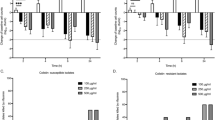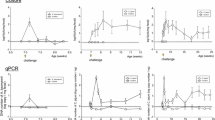Abstract
Aim
Rifaximin is a non-absorbed antibiotic relative of rifampicin. The location of effect and staphylococcal resistance are two recent potential concerns with rifaximin. In this study we evaluate the location of effect of rifaximin as well as the development of staphylococcal rifampicin resistance.
Methods
Rats were divided into three groups. Group 1 gavaged for 10 days with PBS, group 2 gavaged with rifaximin for 10 days, and group 3 gavaged with rifaximin for 10 days and housed for 30 days. In each group, stool was collected daily for quantitative culture of Staphylococcus spp. and coliforms. After euthanasia luminal bacterial counts were determined at multiple gut locations by qPCR. Rifampicin susceptibility was tested on Staphylococcus pre and post rifaximin.
Results
At baseline, rats had a median of 2.90 × 106 cfu/ml Staphylococcus spp. in stool. After 10 days of rifaximin, this dropped to 1.20 × 105 cfu/ml (P < 0.01). With coliform counts, rats had a median of 1.86 × 104 cfu/ml at baseline which dropped to 2.2 × 103 cfu/ml (P < 0.01) after rifaximin. After cessation of rifaximin, coliform counts recovered within 3 days. When examining the total bacterial counts by qPCR, rifaximin reduced small bowel bacterial levels, but not colon. This reduction was sustained for 30 days. No colonies of Staphylococcus became resistant and only one colony was intermediate. The mean inhibitory concentration for rifampicin was not different before and after rifaximin.
Conclusion
Staphylococcal spp. fail to demonstrate resistance to rifampicin after rifaximin. The transient reductions in stool coliform counts recover while rifaximin appears to produce durable reductions in duodenal bacteria.









Similar content being viewed by others
References
Marchi E, Masigianni G, Montecci L, Burfani M, Cellai L. L/105, A new semisynthetic derivative of ryfamicin SV, synthesis and structure-activity relationship. Chemioterapia. 1983;2:38–50.
Descombe JJ, Dubourg D, Picard M, Palazzini E. Pharmacokinetic study of rifaximin after oral administration in healthy volunteers. Int J Clin Pharmacol Res. 1994;14:51–56.
Rizzello F, Rionchetti P, Venturi A, et al. Rifaximin systemic absorption in patients with ulcerative colitis. Eur J Clin Pharmacol. 1998;54:91–93.
Jiang ZD, DuPont HL. In vitro and in vivo antibacterial activity—a review. Chemotherapy. 2005;51:67–72.
Adachi JA, DuPont HL. Rifaximin: a novel non absorbed rifamycin for gastrointestinal disorders. Clin Infec Dis. 2006;42:541–547.
Pimentel M, Lembo A, William DC, Salam Z, et al. Rifaximin therapy for patients with irritable bowel syndrome without constipation. N Engl J Med. 2011;364:22–32.
Posserud I, Stotzer P-O, Bjornsson ES, Abrahamsson H, Simren M. Small intestinal bacterial overgrowth in patients with irritable bowel syndrome. Gut. 2007;56:802–808.
Pyleris E, Giamarellos-Bourboulis EJ, Tzivras O, Koussoulas V, Barbatzas C, Pimentel M. The prevalence of overgrowth by aerobic bacteria in the small intestine by small bowel culture: relationship with irritable bowel syndrome. Dig Dis Sci. 2012;57:1321–1329.
Valentin T, Leitner E, Rohn A, et al. Rifaximin intake leads to emergence of rifampin-resistant staphylococci. J Infect. 2011;62:34–38.
Pimentel M, Morales W, Chua K, et al. Effects of rifaximin treatment and retreatment in non-constipated IBS subjects. Dig Dis Sci. 2011;56:2067–2072.
DuPont HL, Jiang ZD. Influence of rifaximin treatment on susceptibility of intestinal gram-negative flora and enterococci. Clin Microbiol Infect. 2004;10:1009–1011.
DeLeo C, Dftimiadi C, Schito GC. Rapid disappearance from the intestinal tract of bacteria resistant to rifaximin. Drugs Exp Clin Res. 1986;12:979–981.
Marchese A, Alerno A, Pesce A, Debbia EA, Schito GC. In vitro activity of rifaximin, metronidazole and vancomycin against Clostridium difficile and the rate of selection of spontaneously resistant mutants against representative anaerobic and aerobic bacteria, including ammonia-producing species. Chemotherapy. 2000;46:253–266.
Hoover WW, Gerlach EH, Hoban DJ, Eliopoulos GM, Pfaller MA, Jones RN. Antimicrobial activity and spectrum of rifaximin, a new topical rifamycin derivative. Diagn Microbiol Infect Dis. 1993;16:111–118.
Pimentel M, Chatterjee S, Chang C, et al. A new rat model links two contemporary theories in irritable bowel syndrome. Dig Dis Sci. 2008;53:982–989.
Mohammadi T, Reesink HW, Vandenbroucke-Grauls CMJE, Savelkoul PHM. Optimization of real-time PCR assay for rapid and sensitive detection of eubacterial 16S ribosomal DNA in platelet concentrates. J Clin Microbiol. 2003;41:4796–4798.
Johnson S, Schriever C, Galang M, Kelly CP, Gerding DN. Interruption of recurrent Clostridium difficile-associated diarrhea episodes by serial therapy with vancomycin and rifaximin. Clin Infect Dis. 2007;44:846–848.
Frieri G, Pimpo MT, Scarpignato C. Management of colonic diverticular disease. Digestion. 2006;73:58–66.
Fera G, Agostinacchio F, Nigro M, et al. Rifaximin in the treatment of hepatic encephalopathy. Eur J Clin Res. 1993;4:57–66.
Pimentel M. Review of rifaximin as treatment for SIBO and IBS. Expert Opin Investig Drugs. 2009;18:349–358.
Guslandi M. Rifaximin in the treatment of inflammatory bowel disease. World J Gastroenterol. 2011;17:4643–4646.
Shen B, Remzi FH, Lopez AR, Queener E. Rifaximin for maintenance therapy in antibiotic-dependent pouchitis. BMC Gastroenterol. 2008;8:26.
Lanas A, Scarpignato C. Microbial flora in NSAID-induced intestinal damage: a role for antibiotics? Digestion. 2006;73:136–150.
Hartmann G, Honikel K, Knusel F, Nuesch J. The specific inhibition of the DNA-directed RNA synthesis by ryfamycin. Biochim Biophys Acta. 1967;145:843–844.
Livermore DM. Antibiotic resistance in staphylococci. Int J Antimicrob Agent. 2000;16:S3–S10.
Tupin A, Gualtieri M, Roquet-Baneres F, Morichaud Z, Brodolin K, Leonetti JP. Resistance to rifampicin: at the crossroads between ecological, genomic and medical concerns. Int J Antimicrob Agents. 2010;35:519–523.
Aubry-Damon H, Soussy C-J, Courvallin P. Characterization of mutations in the rpoB gene that confer rifampin resistance in Staphylococcus aureus. Antimicrob Agents Chemother. 1998;42:2590–2594.
Dreses-Werringloer U, Padubrin I, Kohler L, Hudson AP. Detection of nucleotide variability in rpoB in both rifampin-sensitive and rifampin-resistant strains of Chlamydia trachomatis. Antimicrob Agents Chemother. 2003;47:2316–2318.
Yu J, Wu J, Francis KP, Purchio TF, Kadurugamuwa JL. Monitoring in vivo fitness of rifampicin-resistant Staphylococcus aureus mutants in a mouse biofilm infection model. J Antimicrob Chemother. 2005;55:528–534.
Brigidi P, Swennen F, Rizzello F, et al. Effects of Rifaximin administration on the intestinal microbiota in patients with ulcerative colitis. J Chemother. 2002;14:290–295.
Stracciari JM, Venturini AP, Anfossi P, Marchi E, Stracciari GI. Sensitivity to rifaximin and rifampin of Mycobacterium tuberculosis isolated from guinea pigs treated orally with rifaximin. Chemioterapia. 1987;6:82–84.
William DL, Spring L, Collins L, et al. Contribution of rpo B mutations to development of rifamycin cross-resistance in Mycobacterium tuberculosis. Antimicrb Agents Chemother. 1998;42:1985–1987.
Soro O, Pesce A, Raggi M, Debbia EA, Schito GC. Selection of rifampin resistant mycobacterium tuberculosis does not occur in the presence if low concentrations of rifaximin. Clin Microbiol Infect. 1997;3:147–151.
Acknowledgments
This investigator-initiated study was supported by a grant from Salix Pharmaceuticals. In addition, this work was further supported by a grant from the Beatrice and Samuel A. Seaver Foundation.
Conflict of interest
Cedars-Sinai has a licensing agreement with Salix Pharmaceuticals. In additions, Drs. Pimentel and Chang are consultants for Salix Pharmaceuticals.
Author information
Authors and Affiliations
Corresponding author
Rights and permissions
About this article
Cite this article
Kim, MS., Morales, W., Hani, A.A. et al. The Effect of Rifaximin on Gut Flora and Staphylococcus Resistance. Dig Dis Sci 58, 1676–1682 (2013). https://doi.org/10.1007/s10620-013-2675-0
Received:
Accepted:
Published:
Issue Date:
DOI: https://doi.org/10.1007/s10620-013-2675-0




